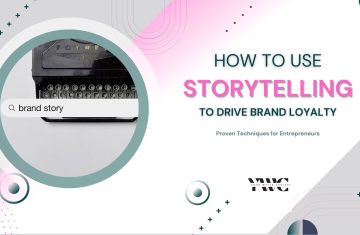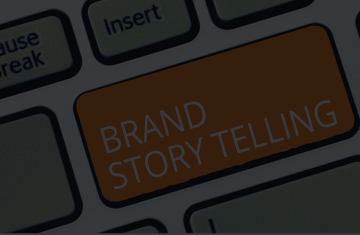Humans are, by nature, storytellers and story-consumers. We’ve been sharing tales around campfires and inscribing them on cave walls since time immemorial. Why? Because stories tap into something fundamental within us, something that transcends logic and data. This innate human connection to stories is the cornerstone of storytelling in marketing to close sales.
Neuroeconomist Paul Zak’s research has shown that stories trigger the release of oxytocin, often referred to as the “love hormone” or “trust hormone.” This neurochemical bath fosters connection, empathy, and a willingness to cooperate. When we hear a story that resonates with us, we’re not just passively absorbing information; we’re experiencing it on an emotional level. This is a marketer’s goldmine when leveraging storytelling in marketing to close sales.
Think about it: Do you remember the last time you were moved by a statistic? Probably not. But I bet you can recall a powerful story that stuck with you long after you heard it. This is the difference between traditional marketing and storytelling in marketing.
Storytelling vs. Traditional Marketing

Traditional marketing often relies on facts, figures, and features to persuade consumers. While this information is important, it rarely ignites passion or creates a lasting impression. In a world saturated with advertisements, our brains have become adept at tuning out this kind of messaging. We’re bombarded with an estimated 4,000 to 10,000 ads every single day!
Storytelling in marketing cuts through the noise. It doesn’t just tell us about a product or service; it shows us how it fits into the lives of real people, solving real problems, and fulfilling real desires. According to a study by Headstream, when people are emotionally invested in a story, they’re 55% more likely to purchase the product or service being advertised.

This demonstrates the power of storytelling in marketing to close sales: forging an emotional connection with potential customers.
Take the example of Warby Parker, the online eyewear retailer. Instead of simply listing the features of their glasses, they tell the story of their founder, Neil Blumenthal, who lost his glasses on a backpacking trip and was frustrated by the high cost of replacements. This relatable anecdote not only humanizes the brand but also establishes a clear value proposition: affordable, stylish eyewear. This is a prime example of how storytelling in marketing can create a compelling narrative around a product.
The Science Behind Storytelling in Marketing
The effectiveness of storytelling in marketing isn’t just anecdotal; it’s backed by science. When we hear a well-crafted story, our brains light up like a Christmas tree. Different parts of the brain are activated depending on the type of story and the emotions it evokes.
For example, stories that involve suspense or surprise activate the amygdala, the brain’s fear center. This heightened emotional state makes us more attentive and engaged with the story. When a story features a character we care about, our brains release oxytocin, strengthening our connection to the narrative and the brand behind it. This neurological response is key to understanding how storytelling in marketing can influence consumer behavior.
Think about how you feel when you watch a movie that makes you laugh, cry, or cheer. Those emotions are not just fleeting reactions; they’re the result of complex neurological processes that storytelling has evolved to exploit. By understanding these processes, marketers can harness the power of storytelling in marketing to close sales.
Core Components of Effective Marketing Stories
Let’s dive into the essential core components of effective marketing stories that can elevate your marketing game and help you close sales:
- Relatable Characters
Your audience should see themselves reflected in your story’s protagonist. This means creating characters who share their struggles, dreams, and aspirations. Remember, people connect with people, not abstract concepts. Think of Dove’s “Real Beauty” campaign, which featured everyday women of different shapes, sizes, and ages. By showcasing relatable characters, Dove tapped into a universal desire for self-acceptance and body positivity.
Mind you, your protagonist doesn’t always have to be a person. It can be a beloved pet, a struggling small business, or even a personified product. The key is to find a character that your audience can empathize with and root for.
- A Compelling Conflict
Conflict is the heart of any good story. It’s what keeps the audience hooked and eager to see how things unfold. In marketing stories, the conflict should be a problem or challenge that your product or service is uniquely positioned to solve. Think of Nike’s “Just Do It” campaign. The conflict isn’t just about physical hurdles; it’s about overcoming mental barriers and pushing past self-doubt.
Remember, the conflict doesn’t have to be grandiose. It can be as simple as a busy mom struggling to find time for herself or a young professional feeling overwhelmed by student loan debt. The key is to tap into a universal pain point that your audience can relate to.
- Emotional Engagement
Facts and figures might inform, but emotions persuade. Your marketing story should evoke feelings that drive action. This could be hope for a better future, fear of missing out, or joy in finding a solution. Consider Apple’s “Shot on iPhone” campaign. It doesn’t just showcase the phone’s camera features; it celebrates the beauty of everyday moments captured through the lens of an iPhone.
To truly master emotional engagement, consider using storytelling techniques like foreshadowing, suspense, and surprise. These tools can keep your audience on the edge of their seats and create a lasting emotional impact.
- Authenticity
In an era of fake news and filtered social media, authenticity is more important than ever. Consumers crave genuine connections with brands they can trust. This means being transparent about your values, your mission, and even your flaws. Patagonia, the outdoor apparel company, is a prime example. Their commitment to environmental sustainability is woven into their marketing stories, creating a sense of shared purpose with their customers.
Remember, authenticity doesn’t mean perfection. It means being real, relatable, and human. Share your brand’s story with honesty and vulnerability, and you’ll earn the trust and loyalty of your audience.
- A Satisfying Resolution
Every good story has a satisfying resolution, and your marketing story is no exception. This is where your product or service steps in as the hero, providing the solution to the conflict and bringing the story to a fulfilling conclusion. Think of how Coca-Cola’s “Share a Coke” campaign transformed a simple bottle of soda into a symbol of connection and friendship.
The key to a satisfying resolution is to show, not just tell, how your offering makes a difference in the lives of your customers. Use testimonials, case studies, or even before-and-after scenarios to demonstrate the transformative power of your product or service.
Types of Marketing Stories That Close Sales
Let’s face it, nobody likes being sold to. But everyone loves a good story. That’s where the magic of storytelling in marketing comes in. It’s not about pushing products; it’s about weaving narratives that resonate with your audience and inspire them to take action. Let’s explore some of the most effective types of marketing stories that can help you close sales without feeling like a pushy salesperson.
1. Customer Success Stories: The Power of Proof
We all love a good underdog story, and customer success stories are the epitome of this. They showcase real people overcoming real challenges with the help of your product or service. These stories are incredibly powerful because they offer social proof and build trust. Potential customers see themselves in these narratives and think, “If they can do it, so can I!”
Take the example of Slack, the workplace communication platform. Their customer success stories feature companies like Airbnb, Shopify, and even NASA, highlighting how Slack has transformed their workflows and boosted productivity. By showcasing these real-world examples, Slack not only demonstrates the value of their product but also establishes themselves as a trusted partner for businesses of all sizes.
2. Origin Stories: The “Why” Behind the Brand
Origin stories tap into our innate curiosity about how things came to be. They reveal the passion, purpose, and values that drive your brand. By sharing your origin story, you humanize your company and create a deeper connection with your audience.
Consider TOMS Shoes, the footwear brand known for its “One for One” giving model. Their origin story tells the tale of founder Blake Mycoskie’s trip to Argentina, where he witnessed children going barefoot. This experience inspired him to create a company that would give a pair of shoes to a child in need for every pair purchased. This compelling narrative has helped TOMS build a loyal following of customers who not only love their products but also believe in their mission.
3. “Us vs. Them” Stories: The Underdog Effect
Humans are wired to root for the underdog. We love stories of David defeating Goliath, of small businesses taking on big corporations, and of individuals overcoming adversity. By positioning your brand as the underdog or champion of a cause, you can tap into this powerful human instinct and rally your audience behind you.
The “Think Different” campaign by Apple is a classic example of an “us vs. them” story. It celebrated innovators, rebels, and misfits who dared to challenge the status quo. This message resonated with consumers who saw themselves as non-conformists and helped Apple establish itself as a brand for those who think outside the box.
4. Product-Focused Stories: The Transformative Power of Your Offering
While showcasing your product’s features and benefits is important, it’s not enough to create a compelling story. Product-focused stories go beyond the technical specifications and demonstrate how your product transforms lives. They showcase the real-world impact of your offering and paint a picture of the positive change it can bring.
One example is GoPro, the action camera company. Their marketing stories don’t just focus on the camera’s durability or image quality; they highlight the incredible experiences people have captured with their GoPros, from surfing giant waves to skydiving from airplanes. These stories inspire viewers to imagine the possibilities and create their own adventures with a GoPro.
5. Visionary Stories: A Glimpse into the Future
Visionary stories paint a picture of a better future that your brand is helping to create. They tap into our hopes, dreams, and aspirations. By showcasing a vision that aligns with your audience’s values and desires, you can inspire them to join you on your journey.
Tesla, the electric car company, is a master of visionary storytelling. Their marketing campaigns often feature futuristic scenarios where Tesla cars are seamlessly integrated into a sustainable, clean-energy world. These stories not only generate excitement for their products but also position Tesla as a leader in the fight against climate change.
How to Integrate Storytelling Across Your Marketing Channels to Close Sales
Let’s explore how you can seamlessly integrate storytelling into various digital platforms, turning cold leads into paying customers:
1. Website
Your website isn’t just a collection of web pages; it’s your brand’s virtual home. Every corner of it should tell a story. Instead of a dry “About Us” page, share the origin story of your company, highlighting the challenges overcome and the milestones achieved. Infuse product descriptions with tales of how they’ve transformed lives, using vivid language and customer testimonials.
Think of your website like a choose-your-own-adventure book, where visitors can explore different sections and uncover captivating narratives that reveal your brand’s personality and values. Remember, every click is an opportunity to engage, entertain, and ultimately, convert.
2. Social Media
Social media platforms are the perfect stage for bite-sized stories that pack a punch. On Instagram and TikTok, utilize short-form videos to share customer testimonials, behind-the-scenes glimpses, or quick product demos. Keep it snappy, visually appealing, and relevant to your audience’s interests.
Consider running a “Story of the Week” series where you feature a different customer each week and share their unique journey with your brand. This not only humanizes your company but also creates a sense of community and belonging among your followers. Remember, social media is a conversation, not a monologue. Encourage user-generated content by inviting your followers to share their own stories related to your brand.
3. Email Marketing
Email marketing is your direct line to your customers’ inboxes. Don’t waste it on generic promotional blasts. Instead, craft personalized narratives that speak directly to their needs and aspirations. Share customer success stories that mirror their own challenges and showcase how your product or service can be their solution.
Think of your emails as chapters in a serialized novel. Each one should build upon the previous, creating anticipation and excitement for what’s to come. Use a conversational tone, as if you’re writing to a friend, and include a call to action that encourages them to continue their journey with your brand.
4. Content Marketing
Your blog isn’t just a platform for SEO-optimized articles; it’s a canvas for rich, long-form narratives that delve deeper into your brand’s story. Share case studies that read like investigative reports, uncovering the hidden benefits of your product or service. Craft blog posts that read like personal essays, revealing your brand’s values and insights.
Think of your content as a documentary series, where each piece uncovers a different facet of your brand’s personality. Use compelling visuals, engaging headlines, and a clear narrative arc to keep your readers hooked from beginning to end.
5. Advertising
Advertising isn’t just about selling; it’s about creating an emotional connection with your audience. Story-driven campaigns are often the most memorable and effective. Think of Nike’s “Just Do It” campaign, which transcended athletic wear and became a cultural phenomenon.
Craft advertisements that tell a story, not just a product pitch. Use humor, suspense, or nostalgia to evoke emotions and create a lasting impression. Remember, the best ads don’t just sell products, they sell dreams, aspirations, and a better version of ourselves.
You May Also Like:
- Top 10 Brands that Have Mastered the Art of Storytelling in Marketing
- How to Measure the Impact of Storytelling in Marketing
Conclusion
The real power of storytelling in marketing lies in its ability to connect with consumers emotionally and logically. By creating story narratives that are relatable, inspiring, and authentic, you can build trust, loyalty, and ultimately close more sales. Remember, it’s not just about what you sell—it’s about the story you tell.
PS: Want to start attracting your desired leads through storytelling that connects and converts? Here’s my free storytelling workbook to get you started.
Need professional help creating relatable marketing stories that drive sales? I’m “your write choice.” Contact me now!










